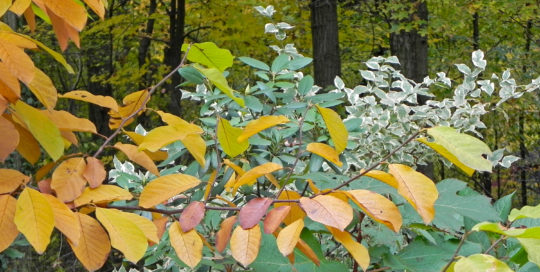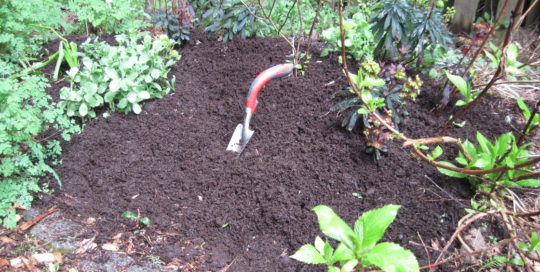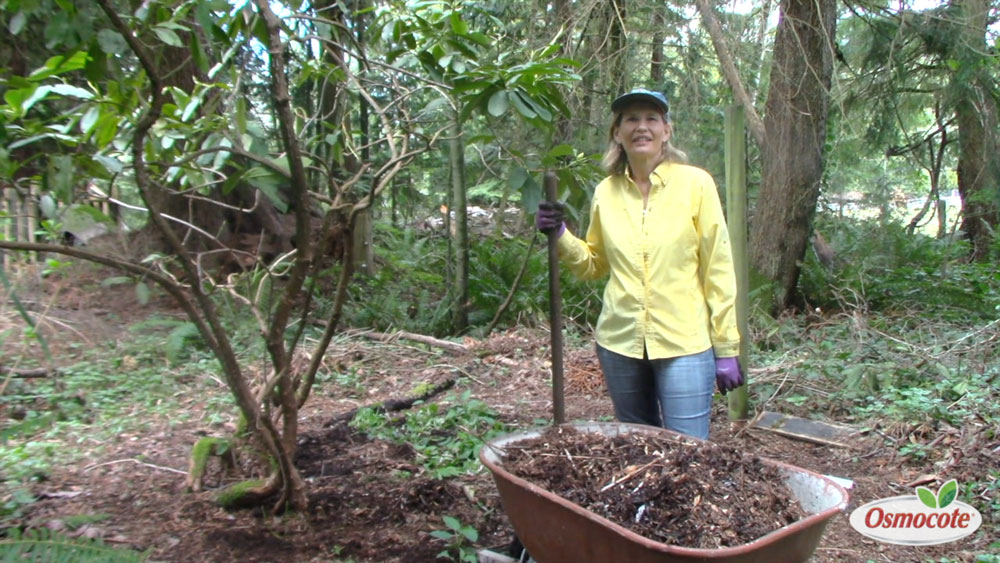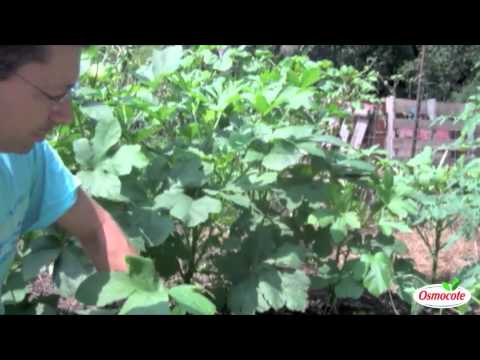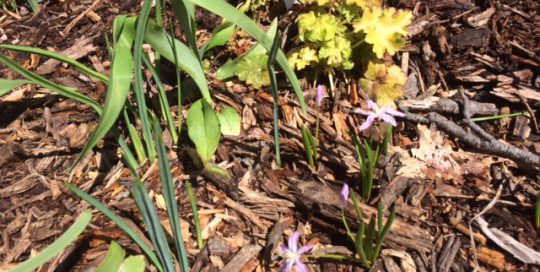At any time of year, a layer of pristine mulch makes the garden look complete. It’s the perfect backdrop, adding cohesiveness to the plants whose roots it covers, turning a collection of plants into a garden. There are lots of pluses to mulching in late fall, and very few minuses. Organic mulch (made from wood or other material that eventually breaks down) protects plants from winter weather.
What: Mulch Types and Uses
Organic
This type of mulch breaks down over time, while inorganic materials (like rock) do not. Organic mulches include shredded or chunk bark. I switched from chunk bark, which breaks down slowly, to shredded mulch when I couldn’t train my dog not to chew the wood chunks when she was in the yard. She found the shredded bark to be a lot less gratifying. Either way, I have found wood mulches of any kind to make the best garden mulch.
Bark and shredded hardwood are by-products of the lumber and paper industries. Shredded bark is available in natural or dyed varieties. Dyed varieties are often a mix of hardwood or recycled wood waste containing artificial dyes.
One of the best—and cheapest—mulches comes from on high. That is when the leaves fall from large shade trees. I have mostly oak leaves and needles from white pines. Oak leaves don’t break down in just one season, however, they’re on the crispy side, so they don’t tend to compact like, for instance, maple leaves. When using oak leaves as mulch, there are two options: After leaves fall, and when the soil is dry, mow over the leaves on the lawn a couple of times until they’re shredded and gather them to use in your beds, or make sure the leaves aren’t piled high enough on plants (under two inches deep) to compact and hold in too much moisture.
Inorganic
Inorganic mulch can include shredded rubber, rock, plastic sheeting and landscape fabric, none of which contribute to the quality of the soil it covers. Recycled rubber from tires has been under scrutiny due to its chemical seepage into the soil and for its flammability. In a report by Linda Chalker-Scott, Extension Horticulturist and Associate Professor for Washington State University, considerations for using recycled rubber in the landscape are listed and explained.
Rock can be an issue for lawn mower blades if it scatters, and it’s certainly not weed-proof. Soil builds up in between the rocks, creating deep pockets for weeds that are all but impossible to pull.
Landscape fabric used around shrubs and trees allows moisture through, and helps keep weeds down. Only use this on long-term planting beds—those that contain trees and/or shrubs. The fabric is a challenge to remove if you want to change the planting bed. Plastic can be used to mulch a garden devoted to annual row crops like vegetables, but should never be used as a landscape mulch for trees, shrubs, or perennials. A growing plant needs air and moisture, which is limited with the use of plastic.
Why Mulch?
Mulch prevents soil from eroding away during heavy rains, and keeps that soil from becoming compacted. As organic mulch breaks down, it adds nutrients and a nice texture to the soil. Well-applied mulch makes springtime gardening easier.
The soil in my gardens are all protected in spring with a layer of shredded bark mulch. In fall, I clear lawn areas, but let the leaves from dozens of oak trees fall on beds with permanent plantings and wait until spring to rake them, gradually as the weather warms, away from the plants.
The Chicago Botanic Garden explains the purpose of a winter mulch:
“A common misconception is that a layer of mulch prevents soil from freezing. It actually lessens the possibility of plants being heaved out of the ground by freeze/thaw cycles. Mulch allows soil to warm up gradually in spring, preventing damage to plants that emerge early before temperatures are warm enough to sustain them. Roses and tender perennials in particular benefit from an application of winter mulch. Remove winter mulch from the base of protected plants in the spring when you observe new growth.”
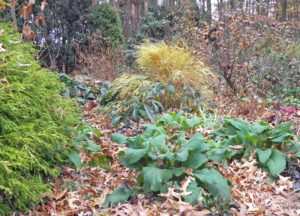
Mulch as a place-saver
I created a few blank canvases in my garden in early October by digging out plants I no longer wanted. I’m not sure what I’ll do with these spots—turn them back to lawn, pave them with a walkway of some kind, or plant something else—but my decision can wait until spring. I covered the bare ground with cardboard, saved up and flattened out shipping boxes I get from my online orders of everything from shoes to garden implements. Then I dumped a generous two inches of cypress mulch over the top. In spring, when I figure out what I’ll be doing with that spot, I will at least not have to deal with weeds.
The Easiest Mulch
One of nature’s best mulches gets a plug by the Soil Society of America, which explains the role of snow and how it benefits soils in winter. Last winter, we saw really cold, windy weather arrive while our garden was vulnerable without its typical blanket of snow. The sequence of cold before snow did a number on some of my boxwood and a tree peony that were out in the open and unprotected by a snow cover.
When: Winter Mulch Timing
While our first instinct is to protect our plants with a thick blanket of mulch, hold that thought—until the ground freezes. Here’s why: mulching too early in the season will prevent plants from hardening off (that’s plant speak for toughening up) in order to withstand the winter. It’s best to wait until the ground has frozen, and mulch to regulate the temperatures, keeping the actions created by the freeze-thaw cycle from damaging plant roots. So how do we know when the ground has frozen? I’ve always considered Thanksgiving, or sometime in late November, the magic date. But there are other cues that tell you it’s okay to mulch.
According to the National Snow and Ice Data Center, University of Colorado, Boulder, ground can freeze anywhere from depth of 6 inches in the southern U.S. to 72 inches deep in the upper Midwest. The National Weather Service says that a hard freeze is possible when temperatures fall below 28°F or-lower for at least a few hours. It usually means that many types of plants and most seasonal vegetation will be destroyed. The best place to determine when your garden will experience a freeze is National Weather Service Frost and Freeze Information page.
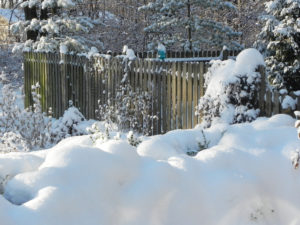
How to Mulch
Never pile mulch on top of perennials, especially on their crown, which is where plant stems and roots meet and new growth forms. Covering this area with mulch can trap water and cause rot. So do I go around and sweep the leaves off my perennials in fall? I don’t remove any leaves except those of my Magnolia ‘Pink Charm’, which are so large and leathery that leaving them would cut off air circulation and promote rot.
Now that we’ve been schooled on the freeze-thaw cycle and the damage it wreaks on roots, there are other dramas going on underground in winter. After the ground freezes, a plant’s roots cannot take up moisture. That would normally be fine, but it’s a different scenario in the case of evergreens. According to H. Edward Reiley in Success with Rododendrons and Azaleas, winter mulch on azaleas and rhododendrons can prevent soil from freezing deeply, allowing some plant roots to pick up moisture. You can apply coarse materials like oak leaves and pine needles three inches deep, make sure to keep any mulch a few inches away from the main stem of the plant. Since there are no feeder roots so close to the stem, drying of the soil is not an issue.
Landscaping
Because conifers are also evergreen (they retain green leaves throughout the year), give them a similar treatment in late fall. The New York Botanical Garden recommends a one to three inch layer that should not touch the base of the conifer. Composted bark and shredded leaves are two good mulch options.
An excellent resource comes from a 2018 journal report of the National Association of County Agricultural Agents, which deconstructs common myths about landscape trees, complete with photos, explaining proper methods for planting, pruning, staking and mulching landscape trees.
Make sure to mulch when it’s cold enough to necessitate wearing gloves and even winter boots. Don’t wait too long, though, because it’s impossible to mulch over snow. Think of mulch as the last tuck in for your garden’s long winter nap. Hardy plants’ roots should be sufficiently cold tolerant to survive the winter, but the peace of mind that a layer of mulch provides heightens our anticipation of uncovering healthy plants come springtime.
Related Blogs
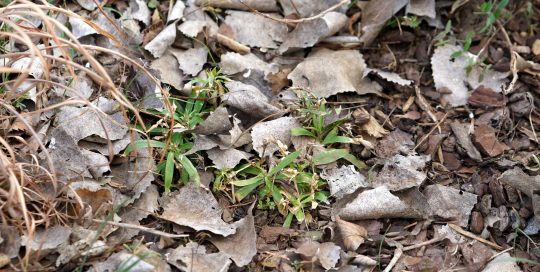
While Potentially Helpful to Birds, Mulching with Leaves can Cause a Problem
Read this post

